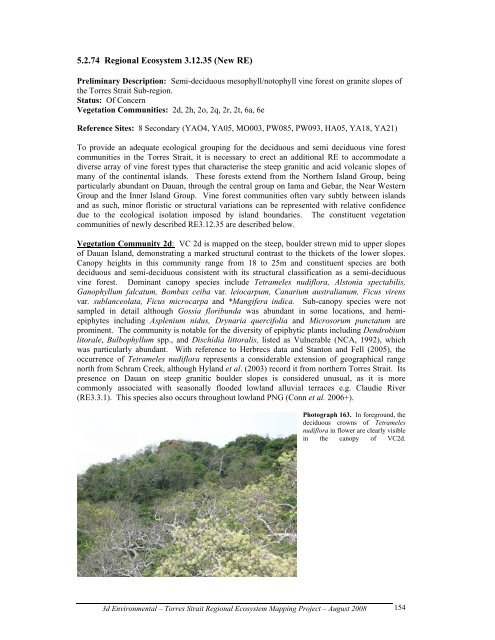Appendix 2 - Vegetation Communities and Regional Ecosystems
Appendix 2 - Vegetation Communities and Regional Ecosystems
Appendix 2 - Vegetation Communities and Regional Ecosystems
You also want an ePaper? Increase the reach of your titles
YUMPU automatically turns print PDFs into web optimized ePapers that Google loves.
5.2.74 <strong>Regional</strong> Ecosystem 3.12.35 (New RE)<br />
Preliminary Description: Semi-deciduous mesophyll/notophyll vine forest on granite slopes of<br />
the Torres Strait Sub-region.<br />
Status: Of Concern<br />
<strong>Vegetation</strong> <strong>Communities</strong>: 2d, 2h, 2o, 2q, 2r, 2t, 6a, 6e<br />
Reference Sites: 8 Secondary (YAO4, YA05, MO003, PW085, PW093, HA05, YA18, YA21)<br />
To provide an adequate ecological grouping for the deciduous <strong>and</strong> semi deciduous vine forest<br />
communities in the Torres Strait, it is necessary to erect an additional RE to accommodate a<br />
diverse array of vine forest types that characterise the steep granitic <strong>and</strong> acid volcanic slopes of<br />
many of the continental isl<strong>and</strong>s. These forests extend from the Northern Isl<strong>and</strong> Group, being<br />
particularly abundant on Dauan, through the central group on Iama <strong>and</strong> Gebar, the Near Western<br />
Group <strong>and</strong> the Inner Isl<strong>and</strong> Group. Vine forest communities often vary subtly between isl<strong>and</strong>s<br />
<strong>and</strong> as such, minor floristic or structural variations can be represented with relative confidence<br />
due to the ecological isolation imposed by isl<strong>and</strong> boundaries. The constituent vegetation<br />
communities of newly described RE3.12.35 are described below.<br />
<strong>Vegetation</strong> Community 2d: VC 2d is mapped on the steep, boulder strewn mid to upper slopes<br />
of Dauan Isl<strong>and</strong>, demonstrating a marked structural contrast to the thickets of the lower slopes.<br />
Canopy heights in this community range from 18 to 25m <strong>and</strong> constituent species are both<br />
deciduous <strong>and</strong> semi-deciduous consistent with its structural classification as a semi-deciduous<br />
vine forest. Dominant canopy species include Tetrameles nudiflora, Alstonia spectabilis,<br />
Ganophyllum falcatum, Bombax ceiba var. leiocarpum, Canarium australianum, Ficus virens<br />
var. sublanceolata, Ficus microcarpa <strong>and</strong> *Mangifera indica. Sub-canopy species were not<br />
sampled in detail although Gossia floribunda was abundant in some locations, <strong>and</strong> hemiepiphytes<br />
including Asplenium nidus, Drynaria quercifolia <strong>and</strong> Microsorum punctatum are<br />
prominent. The community is notable for the diversity of epiphytic plants including Dendrobium<br />
litorale, Bulbophyllum spp., <strong>and</strong> Dischidia littoralis, listed as Vulnerable (NCA, 1992), which<br />
was particularly abundant. With reference to Herbrecs data <strong>and</strong> Stanton <strong>and</strong> Fell (2005), the<br />
occurrence of Tetrameles nudiflora represents a considerable extension of geographical range<br />
north from Schram Creek, although Hyl<strong>and</strong> et al. (2003) record it from northern Torres Strait. Its<br />
presence on Dauan on steep granitic boulder slopes is considered unusual, as it is more<br />
commonly associated with seasonally flooded lowl<strong>and</strong> alluvial terraces e.g. Claudie River<br />
(RE3.3.1). This species also occurs throughout lowl<strong>and</strong> PNG (Conn et al. 2006+).<br />
Photograph 163. In foreground, the<br />
deciduous crowns of Tetrameles<br />
nudiflora in flower are clearly visible<br />
in the canopy of VC2d.<br />
3d Environmental – Torres Strait <strong>Regional</strong> Ecosystem Mapping Project – August 2008<br />
154


